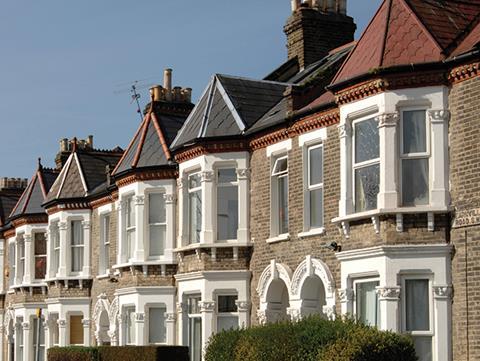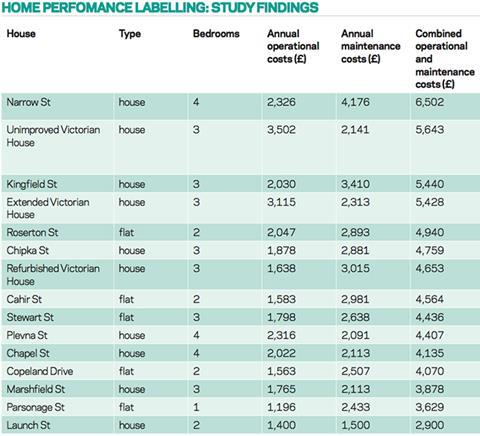New research is casting further doubt on long-held claims that a new-build property is necessarily cheaper to run than a refurbished Victorian home

The topic of housing will be discussed at the Ecobuild event in the Building Debate “The mainstream zero carbon home - will it ever happen?” on Wednesday 4 March, 16:30 - 17:30. For more information, visit www.ecobuild.co.uk
View the full Ecobuild programme here >>
Register for free here >>
It has been one of the housing industry’s rallying cries over the last eight years as it has made the journey toward building zero carbon homes: buy a new home and it’ll be cheaper to run, with far lower fuel bills. While not every builder in the sector has been enthusiastically behind the push to greener homes, iterative upgrades to building regulations mean they are on the zero carbon journey whether they like it or not, so this selling point is now an integral part of the sales patter. Barratt even has a slick interactive graphic on its website telling prospective customers how much they can expect to save each year in fuel bills with a spanking new Barratt home; the industry-wide New Homes Marketing Board’s site has similar data.
It is a claim explicitly endorsed by the government. When then housing minister Grant Shapps set out revisions to the proposed zero carbon standard in 2011, he stated the target was necessary in order to make Britain’s homes “warmer and more comfortable to live in, and at the same time cheaper to run”.
However, while the logic behind the claim seems undeniable, and the push to zero carbon has been endorsed by green groups keen to see more energy-efficient housing, there have been growing concerns that the reality of new-build housing doesn’t quite live up to the rhetoric.
First, consultancies such as Sturgis Carbon Profiling have pointed out that the embodied carbon contained in new-build housing means that the total emissions from a new-build home could be typically no less than from a properly insulated Victorian house.
Secondly, post-occupancy studies of new-build homes have shown a patchy performance from supposedly highly sustainable housing, raising concerns about the so-called “performance gap” between the ways homes are designed on the architects’ drawing board, and the reality of their construction on site.
Now, research conducted by a group of architects, developers and insurers under the aegis of the Housing Forum, is suggesting that the total costs of running and maintaining a new-build property, are not necessarily less than those of a refurbished Victorian home. Why? In simple terms because, while new homes are more energy efficient and keep fuel bills low, these savings are offset by the higher cost of replacing the products which are designed to deliver the more efficient performance. So how robust is this research, and does it mean housebuilders need to start rethinking their sales pitch to home buyers?
Surprising findings
This latest data has emerged as part of a Housing Forum pilot study led by architect HTA and buildings insurer BLP. Called Home Performance Labelling, the study is designed to give better consumer information to home purchasers. The research modelled the average annual operational and maintenance costs of a range of real new-build homes from a selection of architects and developers over the 60-year life span of a building, while performing the same test for a traditional Victorian terraced home (for details, see box below). The first thing that is apparent is the huge variability in the cost of living in a new-build home: while one two-bed flat was estimated to cost just £2,900 a year to operate and maintain, another came out at almost £5,000.
When looking at houses rather than flats, the research unsurprisingly backed the housebuilding industry’s broad assertion that you get cheaper energy bills in new homes compared with Victorian terraces. The unimproved three-bedroom Victorian terrace had the highest operational costs of any of those looked at, at over £3,500. However, when taking into account maintenance costs it was no longer the most expensive, with one of the new-builds (admittedly a four-bedroom home) more expensive to both run and maintain (see results, below).
But it is when looking at the modelled performance of refurbished Victorian houses that the study was most interesting. The refurbished Victorian house had the second lowest operational costs of any of the 10 homes studied, and, at an estimated £4,653, beat many of the new builds for predicted combined operational and maintenance costs.
Peter Mayer, research and development manager at BLP, who helped compile the research, says: “It’s to do with the trade-off between savings on energy bills and the cost of maintaining kit. If you take a basic Victorian house, then clearly modern houses are better. But the work seems to indicate that as you improve a Victorian house, things get much closer. You can end up with a situation where the lifecycle costs are the same or less for Victorian properties that have been refurbished.” In summary, it predicts you are just as likely to pay more overall to live in a new-build home than you are in a well-refurbished Victorian property.
The issue is particularly acute when expensive products are being installed that deliver only small improvements in energy efficiency compared with more traditional and therefore cheaper products, but which will have to be replaced at some point over the life of a home. “An example is triple-glazed windows,” says Mayer. “The thermal performance benefit over double-glazed units is marginal, but their replacement cost is hugely higher.”
Of course the study’s findings need to be treated with a certain amount of caution. First, the outcomes are based on predicted performance, not real post-occupancy studies. Secondly, the pilot has so far only looked at a handful - 15 - of new home designs. And thirdly, the costs of maintenance are dependent upon homeowners carrying out maintenance and replacement at recommended intervals - something which is often not done. But, while Mayer accepts the modelling is theoretical, he says the work highlights an issue of life-cycle costs that is very little understood in domestic buildings. “It brings it out into the open in a way that nothing else has so far. Previously it’s only FM providers or PFI consortiums that have been interested. In terms of the lifecycle cost of running a home, developers currently just don’t tell you what you’re letting yourself in for.”
Poor product performance
And while the study may only really provide an indication of the extent of the problem, the findings are backed up by anecdotal evidence about products, such as some heat pumps and mechanical heat recovery ventilation units (MVHR), being prone to failure and offering poor performance even when working. A 2010 study of 22 installations of air source heat pumps by the Energy Savings Trust found that only one was achieving the expected and marketed performance, with over 50% performing very poorly indeed. A 2012 investigation by the BBC of affordable housing tenants on a new-build estate in which heat pumps were installed, found that some were paying three times their estimated electricity bills because of problems with the equipment.
In terms of the lifecycle cost of running a home, developers currently just don’t tell you what you’re letting yourself in for
Peter Mayer, BLP
David Birkbeck, chief executive of Design for Homes, installed a ground-source heat pump 10 years ago in his home in Thaxted, Essex, in a bid to make it more sustainable and reduce heating bills. “I spent £35k on the pump, which uses three compressors to work. Each one has broken at least once. It failed in 2007, in 2011 and in 2015. I’m sure I’ve spent my fuel bill savings three or four times over.”
Pete Halsall, chief executive of the Good Homes Alliance, says it is now accepted that a lot of the approaches to building highly sustainable homes attempted in the 2000s, in particular with the reliance on district heating systems, have ended up costing residents more in heating than predicted. “The example is biomass boilers - no one had a clue how to specify or operate them. Housing associations have spent a lot of money on them but many are switched off. Likewise heat pumps have been problematic with performance all over the place,” he says. However, he maintains the industry is now making strong progress on the reliability of this technology, with recent systems much more robust.
Often, however, says Maiia Guermanova, an architect and Passivhaus designer at Sturgis Carbon Profiling, it is not necessarily the products themselves but the fact they have not been installed and commissioned correctly that leads to problems with real-life performance. “With new builds often technology is installed and commissioned incorrectly, because the construction industry doesn’t have the skills to do it,” she says. This is a point backed up by David Frise, chief executive of the Association of Interior Specialists, who has written extensively about his experience buying a new-build Code level three flat from a major listed housebuilder. “In order to meet SAP calculations they jump through hoops, which is why we have solar thermal panels on the roof of our block. But no one has ever connected them, despite us sacking our building management company to try and get things changed.”
Performance gap
This point about the installation and commissioning of equipment in new-build homes points to an issue not covered by the Home Performance Labelling research, but which could potentially make their relative performance even worse: the gap between predicted performance and that actually found to occur when homes have been examined after construction. A 2010 study of the Elm Tree Mews homes built by the Joseph Rowntree Housing Trust in line with what was then expected to be 2013 Part L Building Regulations, found the actual heat loss from the homes was more than 50% higher than predicted, the solar thermal panels suffered numerous problems, and the heat pumps performed significantly worse than designed.
Andrew Stunell MP, former building regulations minister and one-time quantity surveyor, says that whatever the findings of the Home Performance Labelling study, it is the real performance of buildings after construction that concerns him. This gap, he says, is partly a failure of construction and commissioning, and partly a failure in consumers understanding how to operate the buildings they live in. “At Elm Tree Mews all the things you might expect to go wrong in construction went wrong, but it was also down to the complexity of the house: it was like you needed a PhD in building science to drive the house.” But Stunell is equally sceptical about the predicted performance of a refurbished Victorian house: “There is a wider and wider gap between performance ratings as calculated, but we all know they’re not going to do that at all.”
For Halsall too it is the performance gap, caused he feels by the lack of skills in the construction industry, that is the biggest challenge. “I feel very pessimistic about it. I don’t think there is the skill level in the industry that there was. The further education system seems to be coming up with no suitable response at all - when I worked on the Middlehaven project, we had £200k to spend on local training initiatives but the colleges were so uninterested we couldn’t spend the money.
“If we take this issue of declining skills and put it next to the requirement for higher performance - then you’ve got one heck of an issue.”
BLP’s Mayer is keen to work on a way to expand the Home Performance Labelling study so that real-life post-occupancy data can be fed into the results, and it is clear more detailed work is needed before the extent of the concern over the running costs of new-build homes can be fully quantified. However, at the very least it seems there is some distance to go before housebuilders can really be sure their homes will deliver the savings to customers their marketing claims.
Home performance Labelling
This study was conducted by architect HTA and BLP as part of the work towards its Home Performance Labelling pilot for the Housing Forum. A range of architects including Alison Brooks Architects, Levitt Bernstein, PRP and PTEa provided full BIM models for designs of new homes, from which the energy performance was calculated. Regulated energy costs were created using SAP, and estimates made from DECC benchmarks on non-regulated energy costs such as cooking and other consumer appliances. Surveys were done of a standard London Victorian terrace to generate similar data. A butterfly model was then applied to this data to devise the wider life-cycle costs. The maintenance and life cycle data was generated from BLP’s in-house costings, service lives and maintenance default data. The costs assumed a 60-year life cycle averaged to an annual figure. A notional service charge was included for flats. Peter Mayer, research and development manager at BLP, said: “Obviously we’ve used assumptions but we’ve tried hard to steer a sensible middle ground.”
Full details on the study can be found at homeperformancelabelling.co.uk. Building is media partner to the Home Performance Labelling pilot.

The topic of housing will be discussed at the Ecobuild event in the Building Debate “The mainstream zero carbon home - will it ever happen?” on Wednesday 4 March, 16:30 - 17:30. For more information, visit www.ecobuild.co.uk
View the full Ecobuild programme here >>
Register for free here >>




























No comments yet